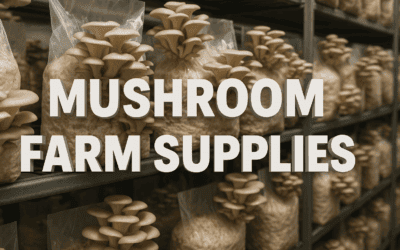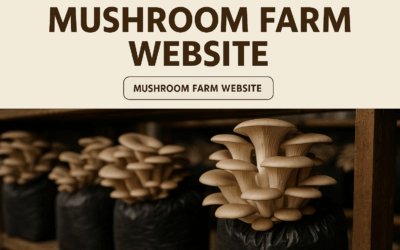TROUBLE SHOOTING
“Preventing is better than solving the problems”
Or a penny of prevention is better than a pound of cure.
If your Mycelium fails to form.
I can me the following things.
Improper initiation strategy.
Consult parameter of growth. Alter moisture, temperature, light, carbon dioxide, etc.
Note: If the substrate is too moist, decrease moisture.
Chlorinated or contaminated water.
Use activated charcoal water filters to eliminate chemical contaminants or any other ways of simple or appropriate technology.
Bad substrate.
Check the substrate. Spread the substrate and remix the substrate, package again, make sure all raw materials are good and fresh.
Note: It is necessary to pasteurize immediately after bagging otherwise fermentation gas will slow down the rate of growth of mycelium or stop mycelium growth.
This is one of the reasons we recommend the Fast Fruiting Mix from MusheroomMediaOnline.com to avoid these kinds of issues.
Bad pasteurization or sterilization.
Check method of pasteurization. Release all air and make sure there is continuous steam before starting pasteurization for a period of 3 hours.
The substrate in the bag is too hot when inoculation
Make sure that the substrate bag is not too hot before inoculation. Let your bags properly cool after your sterilization efforts.
Bad strain or spawn.
Obtain younger strain of known vitality & history.
Spawn contaminated.
Pasteurize and inoculate again with good spawn. This happens and if you screen better with the previous stages it will happen less. If you do a solid job with the previous screening you may still have 3% with issues.
Forgot to inoculate the bag.
Make sure to inoculate. Kind of reminds me of troubleshooting a computer problem and forgetting to check to make sure the computer is plugged in and has power.
Poor spread of mycelium, bad smell, spots and mites.
Good pasteurization but must decrease the temperature in the pasteurization chamber. Pasteurization was too quick and/or the chamber door was opened too quickly.
Slowly decrease the temperature in the chamber. Do not open the cover of the chamber too quickly. Check that the cotton plug is tightly closed.
Inoculation process.
Inoculate in hygiene conditions; clean and with no air movement.
Too high density in the incubation area, not enough ventilation to decrease accumulated temperature.
Spread the substrate bag and make more air ventilation in the incubation area. Check temperature and control surroundings to maintain 25-35 degrees Celsius.
Too high carbon dioxide.
Not more than 5% carbon dioxide. Check ventilation. Remember mushrooms need fresh air just like you and me.
Hygiene of the incubation house.
Improve hygiene in the incubation house.
Mycelium develops in patches. Substrate is not evenly prepared and some parts have more nutrients than others.
Improve your substrate mixing efforts. If you are using the Fast Fruiting mix you should have no issues since the pellets comes premixed and you just need to add water, and mix.
Bacteria, other fungi contamination.
Check the process causing contamination. Separate contaminated bags as soon as possible. Remix substrate separately. Remake substrate bags and pasteurize for a longer time. Follow the process.
Mite contamination.
Immediately separate contaminated bags and pasteurize again. Continue the normal process.
Note:
*Keep hygiene management; make sure to clean everything (person, area, tools, equipment, and surroundings during every step.
*Stop using the area to cut the life cycle of all contaminants for a period of at least 1-2 weeks. For serious contamination cases, spray area with chemicals.
*Use black-light with water or sticky-trap to decrease insects.
Mycelium grows but fails to produce mushrooms.
Substrate formula is not suitable.
Adjust the formula; check pH; sawdust; additives; etc. Again, broken record here but you eliminate this issue with the fast fruiting mix.
Mites, mold, virus, bacteria and insects.
Check pasteurization process, inoculation, other processes and mushroom house management for hygiene.
Inhibited by environmental toxins.
Remove the source of toxins.
Bad strain or spawn
Get yourself a new strain or spawn.
Mushrooms form, but stems are long; caps underdeveloped.
Inadequate light.
Increase or adjust the light to the correct wavelength. One thing that helps with some breeds is opening holes in the grow bags from the side closest to the light source. If you are growing on racks then just as you would try and make sure a pant receives sunlight, you want to make sure your mushrooms get light as well.
Excessive carbon dioxide.
Increase air exchange, open doors or windows and close at the correct time.
Mushrooms produced only in the first flush, fail to produce subsequent flushes.
|
Inadequate substrate nutrition. |
It is time to review your substrate. The reason we make the Fast Fruiting mix at 50/50 soy hull and oak pellets it to assure that the substrate has abundant nutrition.
Competitors.
Check hygiene, adjust light, temperature, humidity, air and ventilation.
Bad strain.
Again, get your hands on another strain.
Mushroom Farm Supplies
The Best Mushroom Farm Supplies for Successful Growth Key Highlights Starting your mushroom farm requires the right mushroom farm supplies for success. High-quality substrates and grains are the foundation of healthy mushroom cultivation. Choosing cost-effective,...
Leveraging Chat Message Tools for Your Mushroom Farm Business: A Complete Guide
Leveraging Chat Message Tools. In the evolving landscape of digital marketing, chat message tools and chatbots have emerged as one of the most powerful yet often overlooked marketing channels available to mushroom farmers. With over 80% open rates—the highest...
Effective Email Marketing for Your Mushroom Farm Business: A Complete Guide
Effective Email marketing remains one of the most powerful yet underutilized marketing tools available to mushroom farmers. When done correctly, email marketing can generate up to $40 in return for every dollar spent, making it one of the highest ROI marketing...
How to Use Video Shorts to Grow Your Mushroom Farming Business Online
In today's fast-paced digital world, mushroom farmers need to think beyond traditional marketing methods to reach their ideal customers. Video shorts are a great low cost option. While farmers markets and word-of-mouth referrals remain important, the power of social...
Getting the Most Out of Your Business or Farm Website A Complete Guide for Mushroom Farmers
Your website isn't just a digital business card anymore—it's your most powerful marketing tool, primary sales platform, and often the first impression potential customers have of your farm. This comprehensive guide will show you how to transform your website from a...
The Complete Guide to Unicorn Grow Bags: Why Professional Mushroom Farmers Choose American-Made Quality
For an in-depth discussion about Unicorn Grow Bags, check out our latest Mushroom Farming Podcast episode where host Monica sits down with online marketing expert Harry Warrick to explore everything you need to know about selecting and using these industry-standard...
Mushroom Farm Websites
Why Your Mushroom Farm Needs a Website The Complete Guide to Digital Marketing SuccessListen to our new mushroom farming podcast about mushroom farm websites. In today's digital marketplace, having a strong online presence isn't just an advantage for mushroom...
Mushroom Farming Podcast Ep 3 YouTube Channel
Why Every Mushroom Farm Needs a YouTube Channel: The Second-Most Powerful Search Engine You're Ignoring Based on Episode 3 of The Mushroom Farming Podcast Every Mushroom Farm needs a YouTube Channel. Your mushroom farm has a Google Business Profile. You've optimized...
Mushroom Farming Podcast Episode 2
Why Your Mushroom Farm Needs a Google Business Profile: The Key to Map Pack Domination Based on Episode 2 of The Mushroom Farming Podcast If you're growing gourmet mushrooms and wondering why some farms seem to get all the local customers while you're struggling to be...








